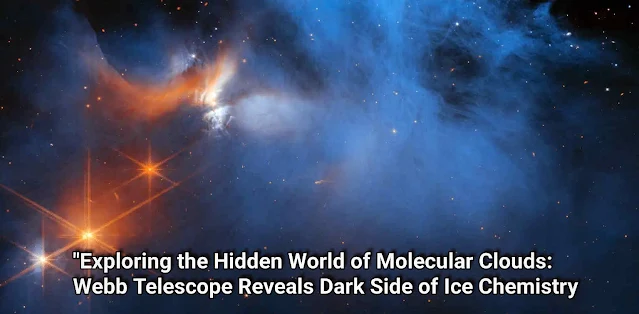Exploring the Hidden World of Molecular Clouds: Webb Telescope Reveals Dark Side of Ice Chemistry
An international team of astronomers using NASA’s James Webb Space Telescope (JWST) has obtained an in-depth inventory of the deepest, coldest ices measured to date in a molecular cloud. In addition to simple ices like water, the team was able to identify frozen forms of a wide range of molecules, from carbonyl sulfide, ammonia, and methane, to the simplest complex organic molecule, methanol. This is the most comprehensive census to date of the icy ingredients available to make future generations of stars and planets, before they are heated during the formation of young stars.
The JWST's powerful infrared capabilities allow scientists to study the ice-covered dust grains in molecular clouds with unprecedented precision, providing new insights into the processes that lead to the formation of new stars and planets. The discovery of these complex molecules in the ice of molecular clouds suggests that the building blocks of life may be more prevalent in the universe than previously thought.
The study is a groundbreaking achievement and it provides a glimpse into the complex chemistry that takes place in the cold, dark depths of molecular clouds. The team's observations open a new window on the formation pathways for the simple and complex molecules that are needed to make the building blocks of life. These findings could mean that the presence of precursors to prebiotic molecules in planetary systems is a common result of star formation, rather than a unique feature of our own solar system.
The James Webb Space Telescope (JWST) is set to revolutionize our understanding of the universe when it launches in 2021. One of its key areas of research will be the study of molecular clouds, the dense regions of gas and dust where new stars and planetary systems are born. In a recent study, a team of scientists used the JWST to peer into the frozen heart of a molecular cloud, revealing new insights into the dark side of pre-stellar ice chemistry.
Molecular clouds are incredibly cold, with temperatures dropping as low as -263 degrees Celsius. At these temperatures, molecules of water, carbon dioxide, and other compounds freeze out of the gas phase and form ice on the surfaces of dust grains. This process, called freeze-out, is thought to play a key role in the formation of new stars and planets.
The JWST, with its powerful infrared capabilities, will be able to study these ice-covered dust grains in unprecedented detail. In the recent study, the team used the JWST's Near Infrared Camera (NIRCam) to observe a nearby molecular cloud called Barnard 68. By analyzing the light from the cloud, the team was able to identify more than 20 different ice species, including water, carbon dioxide, and methane.
The team also made an unexpected discovery: the ice in Barnard 68 contained a high abundance of complex organic molecules, including formaldehyde and methanol. These molecules are thought to be precursors to more complex organic compounds, such as amino acids, that are necessary for life as we know it.
The James Webb Space Telescope will be able to observe many more molecular clouds in the coming years, and it is expected to provide new insights into the processes that lead to the formation of new stars and planets. With its powerful instruments, the JWST will allow scientists to unravel the secrets of the universe and pave the way for future discoveries.
Unveiling the Complex Chemistry of Molecular Clouds: James Webb Space Telescope Identifies Frozen Forms of Key Molecules.
The James Webb Space Telescope (JWST) has the capability to study the icy dust grains that are found in molecular clouds in great detail. In a recent study, scientists used the JWST's Near Infrared Camera (NIRCam) to observe a nearby molecular cloud called Barnard 68, and were able to identify over 20 different ice species. The team identified frozen forms of a wide range of molecules including water, carbon dioxide, ammonia, and methane, which are all thought to play a key role in the formation of new stars and planetary systems.
The JWST's powerful infrared capabilities allow scientists to study the ice-covered dust grains in molecular clouds with unprecedented precision, which is providing new insights into the processes that lead to the formation of new stars and planets. The discovery of these complex molecules in the ice of Barnard 68 suggests that the building blocks of life may be more prevalent in the universe than previously thought.
The James Webb Space Telescope will be able to observe many more molecular clouds in the coming years, and it is expected to provide new insights into the processes that lead to the formation of new stars and planets. With its powerful instruments, the JWST will allow scientists to unravel the secrets of the universe and pave the way for future discoveries.

